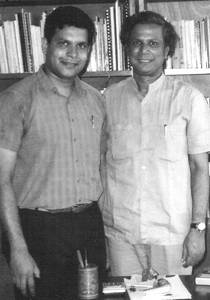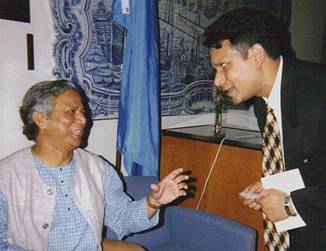The Humanity of Muhammad Yunis
by Arvind Singhal
Much has been written about Professor Yunus and his tireless efforts in more than three decades to alleviate global poverty; or, in his words: "to put poverty in the museums for our children to see."¯ Less so has been said about Yunus, the man; his humanity. In the past 16 years, I have had the opportunity to meet Professor Yunus on three occasions. I have vivid memories of all three meetings and will share one anecdote from each meeting to show the warm, gracious and thoughtful Dr. Yunus.
1991
Flashback to the summer of 1991. I am in a tall brick building in the Mirpur section of Dhaka with Mohammed Auwal, a Bangladeshi graduate student at Ohio University, sitting outside Professor Yunus's office. Dr. Yunus had arrived back in Dhaka the previous night from an overseas trip, which explained the five other people waiting to see him. In my hands is a term paper that Auwal wrote for my 1990 fall semester class in innovation diffusion.
Auwal's paper introduced me to Professor Yunus, his unshakeable faith in the potential of poor people"”some call it "Yunusonomics""”and the organisation he founded, the Grameen (Rural) Bank, a for-profit bank specialising in disbursing collateral-free loans to the poorest-of-the-poor and boasting a loan recovery rate of 98 percent. Yunus's belief that the poor could be creditworthy ran counter to the prevailing tenet of banking: Providing credit without collateral is bad business.
I am eager to meet this "poor man's banker,"¯ who argues that conventional banking policies are pro-rich, pro-urban, and pro-male"”that is, unjust and flawed.
A charismatic man wearing a khaki-yellow, half-sleeve Nehru shirt and light brown pants, approaches me, smiling and extending a firm, warm hand.
"Professor Singhal, I am Yunus."¯
Taken aback by the realization that Professor Yunus has come out of his office to personally welcome us, as opposed to instructing his secretary to let us in, I am at a loss of words. I mumble: "Dr. Yunus, I am Arvind Singhal. This is my colleague Mohammed Auwal. How nice of you to make time for us in your busy schedule."¯
"It is my pleasure. You are the ones who have come such a long way to see us. How nice of you to do so,"¯ he responds. "Welcome to the Grameen Bank."¯ He ushers us into his office.
We connect instantly.
We chat for about 45 minutes"”we are scheduled, I believe, for 15 minutes"”but never once does he give us the impression that he is in a hurry. He asks us if we had visited some Grameen Bank centres in Bangladesh; and when we respond that we had not, but would like to, he calls his assistant to help arrange two all-day field visits for us.
He is insistent that, in order to understand what the Grameen Bank is all about, we should spend most of our time with Grameen Bank members in the rural locales where they live. When we ask if we can have access to some of the internal publications on the Grameen Bank, he gives us an up-dated list of available publications and personally calls the librarian to facilitate our digging.
As we say our goodbyes, he gives us his card and says we can write him, fax him or call him or his office for any further follow-up. And then, graciously, he poses for a photo.

(L to R) Singhal and Yunus, Dhaka, 1991
1999
Flashback to June 1999. Yunus' book Banker to the Poor has just been released, and he is in New York City for a book-signing event as well as to raise funds for the Grameen Foundation. The venue is the United Nations headquarters, in a large ballroom overlooking the Hudson River. Some 250 people, including luminaries such as ABC news anchor Peter Jennings and CNN Chairman Ted Turner, have gathered for a celebratory dinner. I find myself at a table with several university students representing the South Asian Student Association (SASA). Two of them, both from Bangladesh and both sophomores at Columbia University, nervously clutch a disposable camera, wondering if Professor Yunus will make his way to our table.
Mingling with ease with both the glitterati and the "commoners,"¯ Professor Yunus is on his feet for three hours . The event is winding down, but he makes it to our table, pulls up a chair and gives his feet some rest. While we nibble on our desserts, he talks to each one of us, genuinely interested in who we are. When I tell him that we had met in 1991, and corresponded several times after that, he asks me how my colleague Auwal is (How could he remember his name, I wonder?). Then he thanks me for sending him, over the years, several of our publications on the Grameen Bank, including a copy of Auwal's doctoral dissertation. It doesn't seem that eight years have gone by since out last meeting; we seem to pick up the threads from where we left them in 1991.
Later, that evening, when the formal part of the event is over, and we move to the reception lobby, Professor Yunus gives us signed copies of his new book, personalizing it for each of us. The two nervous Columbia University students hand me their camera; and flock around a beaming Professor Yunus. I almost shoot up their entire roll of film. They asked me if I would like a photo with Professor Yunus; and they snapped an image of the two of us. A few months later, this print arrived from New York City.

Professor Yunus and Arvind, New York City, 1999
2001
In 1997, the Grameen Bank, in cooperation with Telenor, established a for-profit company called GrameenPhone to dispense mobile telephony services in urban areas. The Bank also established with Telenor a nonprofit organization called Grameen Telecom. The vision: placing at least one mobile phone in each of the 75,000 villages of Bangladesh.
At that time, there was one telephone in Bangladesh for every 400 people, one of the lowest telephone densities in the world. There was virtually no access to telephony services in rural areas.
Yunus realized that while it was not possible for each rural household to own a telephone, it would be possible through mobile telephone technology to provide access to each villager. So he initiated Village Telephone Ladies as part of Grameen Telecom's expansion into rural Bangladesh. In each village, one, or more Grameen Bank women members took a loan to purchase or lease a mobile telephone unit, making them vendors of telephony services. It was a win-win arrangement: The women benefited because they now had an independent revenue source. The villagers benefited because they were now "connected"¯ to the rest of Bangladesh and to the world. Plus, the arrangement obviated the need to install expensive large-scale telephone exchanges and digital switching systems.
Ten years after Grameen telephony operations were launched, almost all Bangladeshi villages have access to telephony. The for-profit GrameenPhone Company, boasting more than 10 million subscribers, is a cash cow, and considered a jewel in the overseas mobile telephony portfolio of Norway's Telenor.
Flashback to May 2001. I am in Dhaka, conducting a study of the Grameen village telephony project in association with Telenor. With me is Peer Svenkerud, an Ohio University alumni whose doctoral committee I chaired. Our car pulls up to the headquarters of the Grameen Bank. I gasp.
We are standing in front of a skyscraper, the new offices of the Grameen Bank; or more appropriately, the Grameen Social Conglomerate. It could well have been the Bangladeshi headquarters of Bank of America. The Grameen had covered a lot of ground in the 10 years since I last visited Dhaka.

(L to R) Arvind, Yunus, Einar Flydal
and Peer Svenkerud, Dhaka, 1999
Notwithstanding a taller building, and a large corner office on one of the earlier floors, Yunus' warmth has not diminished. If anything, we connect even more. When our 30-minute meeting has turned into an hour, thanks to our free-flowing conversation about the Grameen telephony operations, and the welcome interruption of tea, sweet yoghurt and samosas, Yunus senses my edginess and says: "Arvind, what do you say we try to wrap in about 15 to 20 minutes."¯ But we stayed another 30 minutes.
* * * *
Professor Yunus, 2006 Nobel Peace Prize winner, is a giant of man, not only because of his accomplishments, but because he never makes anyone feel small.


